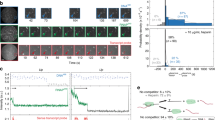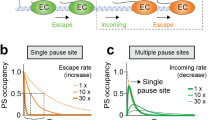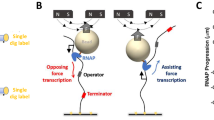Abstract
Biochemical and structural studies have shown that the initiation of RNA polymerase II transcription proceeds in the following stages: assembly of the polymerase with general transcription factors and promoter DNA in a ‘closed’ preinitiation complex (PIC)1,2; unwinding of about 15 base pairs of the promoter DNA to form an ‘open’ complex3,4; scanning downstream to a transcription start site; synthesis of a short transcript, thought to be about 10 nucleotides long; and promoter escape. Here we have assembled a 32-protein, 1.5-megadalton PIC5 derived from Saccharomyces cerevisiae, and observe subsequent initiation processes in real time with optical tweezers6. Contrary to expectation, scanning driven by the transcription factor IIH7,8,9,10,11,12 involved the rapid opening of an extended transcription bubble, averaging 85 base pairs, accompanied by the synthesis of a transcript up to the entire length of the extended bubble, followed by promoter escape. PICs that failed to achieve promoter escape nevertheless formed open complexes and extended bubbles, which collapsed back to closed or open complexes, resulting in repeated futile scanning.
This is a preview of subscription content, access via your institution
Access options
Subscribe to this journal
Receive 51 print issues and online access
$199.00 per year
only $3.90 per issue
Buy this article
- Purchase on Springer Link
- Instant access to full article PDF
Prices may be subject to local taxes which are calculated during checkout



Similar content being viewed by others
References
Conaway, R. C. & Conaway, J. W. General initiation factors for RNA polymerase II. Annu. Rev. Biochem. 62, 161–190 (1993)
Kornberg, R. D. The molecular basis of eukaryotic transcription. Proc. Natl Acad. Sci. USA 104, 12955–12961 (2007)
Holstege, F. C., Fiedler, U. & Timmers, H. T. Three transitions in the RNA polymerase II transcription complex during initiation. EMBO J. 16, 7468–7480 (1997)
Pal, M., Ponticelli, A. S. & Luse, D. S. The role of the transcription bubble and TFIIB in promoter clearance by RNA polymerase II. Mol. Cell 19, 101–110 (2005)
Murakami, K. et al. Formation and fate of a complete, 31-protein, RNA polymerase II transcription initiation complex. J. Biol. Chem. 288, 6325–6332 (2013)
Fazal, F. M. & Block, S. M. Optical tweezers study life under tension. Nature Photon. 5, 318–321 (2011)
Sawadogo, M. & Roeder, R. G. Energy requirement for specific transcription initiation by the human RNA polymerase II system. J. Biol. Chem. 259, 5321–5326 (1984)
Schaeffer, L. et al. DNA repair helicase: a component of BTF2 (TFIIH) basic transcription factor. Science 260, 58–63 (1993)
Svejstrup, J. Q. et al. Different forms of TFIIH for transcription and DNA repair: holo-TFIIH and a nucleotide excision repairosome. Cell 80, 21–28 (1995)
Dvir, A. et al. A role for ATP and TFIIH in activation of the RNA polymerase II preinitiation complex prior to transcription initiation. J. Biol. Chem. 271, 7245–7248 (1996)
Kim, T. K., Ebright, R. H. & Reinberg, D. Mechanism of ATP-dependent promoter melting by transcription factor IIH. Science 288, 1418–1421 (2000)
Grünberg, S., Warfield, L. & Hahn, S. Architecture of the RNA polymerase II preinitiation complex and mechanism of ATP-dependent promoter opening. Nature Struct. Mol. Biol. 19, 788–796 (2012)
Galburt, E. A. et al. Backtracking determines the force sensitivity of RNAP II in a factor-dependent manner. Nature 446, 820–823 (2007)
Larson, M. H. et al. Trigger loop dynamics mediate the balance between the transcriptional fidelity and speed of RNA polymerase II. Proc. Natl Acad. Sci. USA 109, 6555–6560 (2012)
Schweikhard, V. et al. Transcription factors TFIIF and TFIIS promote transcript elongation by RNA polymerase II by synergistic and independent mechanisms. Proc. Natl Acad. Sci. USA 111, 6642–6647 (2014)
Sikorski, T. W. et al. Sub1 and RPA associate with RNA polymerase II at different stages of transcription. Mol. Cell 44, 397–409 (2011)
Murakami, K. et al. Uncoupling promoter opening from start-site scanning. Mol. Cell 59, 133–138 (2015)
Feaver, W. J., Svejstrup, J. Q., Henry, N. L. & Kornberg, R. D. Relationship of CDK-activating kinase and RNA polymerase II CTD kinase TFIIH/TFIIK. Cell 79, 1103–1109 (1994)
Roy, R. et al. The MO15 cell cycle kinase is associated with the TFIIH transcription-DNA repair factor. Cell 79, 1093–1101 (1994)
Gnatt, A. L., Cramer, P., Fu, J., Bushnell, D. A. & Kornberg, R. D. Structural basis of transcription: an RNA polymerase II elongation complex at 3.3 Å resolution. Science 292, 1876–1882 (2001)
Giardina, C., Perez-Riba, M. & Lis, J. T. Promoter melting and TFIID complexes on Drosophila genes in vivo . Genes Dev. 6, 2190–2200 (1992)
Giardina, C. & Lis, J. T. DNA melting on yeast RNA polymerase II promoters. Science 261, 759–762 (1993)
Giardina, C. & Lis, J. T. Dynamic protein–DNA architecture of a yeast heat shock promoter. Mol. Cell. Biol. 15, 2737–2744 (1995)
Dvir, A., Conaway, R. C. & Conaway, J. W. A role for TFIIH in controlling the activity of early RNA polymerase II elongation complexes. Proc. Natl Acad. Sci. USA 94, 9006–9010 (1997)
Spangler, L., Wang, X., Conaway, J. W., Conaway, R. C. & Dvir, A. TFIIH action in transcription initiation and promoter escape requires distinct regions of downstream promoter DNA. Proc. Natl Acad. Sci. USA 98, 5544–5549 (2001)
Kapanidis, A. N. et al. Initial transcription by RNA polymerase proceeds through a DNA-scrunching mechanism. Science 314, 1144–1147 (2006)
Revyakin, A., Liu, C., Ebright, R. H. & Strick, T. R. Abortive initiation and productive initiation by RNA polymerase involve DNA scrunching. Science 314, 1139–1143 (2006)
Miller, G. & Hahn, S. A DNA-tethered cleavage probe reveals the path for promoter DNA in the yeast preinitiation complex. Nature Struct. Mol. Biol. 13, 603–610 (2006)
Murakami, K. et al. Architecture of an RNA polymerase II transcription pre-initiation complex. Science 342, 1238724 (2013)
Sandelin, A. et al. Mammalian RNA polymerase II core promoters: insights from genome-wide studies. Nature Rev. Genet. 8, 424–436 (2007)
Laybourn, P. J. & Dahmus, M. E. Phosphorylation of RNA polymerase IIA occurs subsequent to interaction with the promoter and before the initiation of transcription. J. Biol. Chem. 265, 13165–13173 (1990)
Feaver, W. J., Gileadi, O., Li, Y. & Kornberg, R. D. CTD kinase associated with yeast RNA polymerase II initiation factor b. Cell 67, 1223–1230 (1991)
Koslover, D. J., Fazal, F. M., Mooney, R. A., Landick, R. & Block, S. M. Binding and translocation of termination factor rho studied at the single-molecule level. J. Mol. Biol. 423, 664–676 (2012)
Murakami, K. et al. Tfb6, a previously unidentified subunit of the general transcription factor TFIIH, facilitates dissociation of Ssl2 helicase after transcription initiation. Proc. Natl Acad. Sci. USA 109, 4816–4821 (2012)
Ge, H. & Roeder, R. G. Purification, cloning, and characterization of a human coactivator, PC4, that mediates transcriptional activation of class II genes. Cell 78, 513–523 (1994)
Henry, N. L., Bushnell, D. A. & Kornberg, R. D. A yeast transcriptional stimulatory protein similar to human PC4. J. Biol. Chem. 271, 21842–21847 (1996)
Malik, S., Guermah, M. & Roeder, R. G. A dynamic model for PC4 coactivator function in RNA polymerase II transcription. Proc. Natl Acad. Sci. USA 95, 2192–2197 (1998)
Neuman, K. C., Abbondanzieri, E. A., Landick, R., Gelles, J. & Block, S. M. Ubiquitous transcriptional pausing is independent of RNA polymerase backtracking. Cell 115, 437–447 (2003)
Acknowledgements
We thank A. Chakraborty and B. Milic for careful reading of the manuscript, P.-J. Mattei for help with protein purification, and R. Landick and J. Gelles for discussions. This research was supported by NIH grants GM36659 and AI21144 to R.D.K. and GM57035 to S.M.B., and an NSF graduate fellowship to F.M.F.
Author information
Authors and Affiliations
Contributions
F.M.F., C.A.M. and K.M. designed the experiments with input from, and supervision by, S.M.B. and R.D.K. F.M.F. and C.A.M. collected the single-molecule data. K.M. purified and reconstituted the PIC components, and performed the bulk experiments. F.M.F. analysed the single-molecule data, and C.A.M. and K.M. carried out the modelling. F.M.F., C.A.M., K.M., S.M.B. and R.D.K. wrote the paper.
Corresponding authors
Ethics declarations
Competing interests
The authors declare no competing financial interests.
Extended data figures and tables
Extended Data Figure 1 The 29-component PIC assembled on SNR20* short promoter.
a, PIC excluding the kinase domain (TFIIK) was assembled on SNR20* short (adjacent to the 2.7-kb downstream handle sequence) and sedimented on a glycerol gradient; fractions were analysed by SDS–PAGE. b, The results from fraction 12, annotated in detail, indicate that all PIC components were retained, confirming that the complex reconstituted fully from the component proteins. The subunit(s) of Pol II are labelled in black, TFIIF in blue, TFIIE in magenta, TFIIH in orange, TFIIA in cyan, TFIIB in red, TBP in light green, and Sub1 in dark green. TFIIK (3-subunits) was later added to the PIC.
Extended Data Figure 2 Schematic diagram showing assembly of dumbbells, in cross-section.
PICs were attached to one bead via biotin-avidin linkages (yellow). To form dumbbell tethers, the other end of a small fraction of the PICs (4%) had digoxigenin linkages that could be tethered to anti-digoxigenin-coated beads (black and brown) via a 2.7-kb DNA handle. PICs not involved in tether formation served to increase the local concentration of PIC components.
Extended Data Figure 3 Run-off transcription under single-molecule assay conditions.
a, Isolated PICs (0.1 pmol), formed on the SNR20* short promoter fragment fused to the transcription template (covering the region −62/+636), and attached to a 2.7 kb DNA handle, was combined with increasing amounts of PICs assembled on the SNR20* short promoter, but without the handle, hereafter referred to as PIC (−62/+96). These constituents were incubated with an equal volume of a 2X NTP solution (10 ml) containing 1.6 mM ATP, 1.6 mM GTP, 1.6 mM CTP, 40 mM UTP, and 0.83 mM [α-32P] UTP (2.5 μCi). The resulting transcripts were analyzed by gel electrophoresis. PICs fused to the DNA handle failed to support transcription alone (lane 1), but transcription activity was restored (red arrow) when a 4-fold (lane 2), 8-fold (lane 3), 12-fold (lane 4), or 15-fold (lane 5) excess of PIC (−62/+96) was added to the reactions. In lane 6, the reaction contains 1.5 pmol PIC (−62/+96). The 96-nt run-off transcription from PIC (−62/+96) is indicated (black arrow). A 25-fold excess of PIC (−62/+96) was used for single-molecule assays (Extended Figure. 2). b, 1.5 pmol aliquots of PIC (−62/+96) were introduced into different volumes of transcription buffer, such that assayed concentration of PIC varied from 37 nM to 4.5 nM. Transcription efficiency (run-off band, black) decreased with PIC concentration from ∼18% to just 2–3%. The low concentrations used in single-molecule assays (<1 nM) could not be assayed directly using gels, but we expect that the transcription efficiency is correspondingly low.
Extended Data Figure 4 Records of TFIIH scanning on SNR20* long with rNTPs or dATP.
a, b, Just as for SNR20* short (Fig. 3), the longer promoter shows TFIIH scanning with both rNTPs (a) or dATP only (b), after which either the PIC dissociates (black arrows), or the bubble collapses to the closed (blue and green records) or open (grey line) complex and TFIIH moves again. The dashed line indicates the position of the TSS (+1).
Extended Data Figure 5 Exonuclease III footprinting assay of the PIC on SNR20* long.
In the absence of nucleotides in vitro, PIC complexes bound to the SNR20* long promoter produced barriers to exonuclease III digestion located ∼50 bp downstream of the TATA box (about −40 nucleotides from the TSS, black arrows). These barriers depended on the presence of TFIIH and also TFIIE, which interacts with TFIIH. After the addition of dATP, the barriers disappeared, and the bands at pause positions were intensified between positions −30 and +30 (∼60–120 bp downstream of the TATA box, bracket).
Extended Data Figure 6 The transcription initiation pathway for SNR20* long (left) and SNR20* short (right) promoters.
Left, a model for the initiation pathway on the SNR20* long promoter. States starting from the top: Pol II (beige) with attached GTFs (blue) and Ssl2 (orange) binds in its ‘closed’ form to the promoter element upstream of the TSS (arrow) on the DNA template (green and blue lines). Positions of the enzyme active site (open white circle) and TATA box (closed black square) are indicated. Unwinding by TFIIH produces an open complex (OC) that leads to bubble formation. Arrival of the open complex at the TSS owing to scanning, driven by TFIIH, leads to the formation of an extended bubble (dashed lines indicate the speculative position of single-stranded DNA). If the complex fails to recognize the TSS, it can be driven beyond it by TFIIH, resulting in a ‘fast state’ that produces no RNA but advances at roughly twice the normal rate (black box; see text). When Pol II recognizes the TSS, it begins transcription of RNA (red line), corresponding to the ITC. Formation of the ITC leads to bubble collapse, followed by the loss of GTFs and transition to the elongation complex (EC). Right, corresponding model for the initiation pathway on the SNR20* short promoter. Similar states as for SNR20* long. In this case, the open complex does not need to scan for the TSS, which is found within its DNA footprint. As a consequence, the ITC can form and begin RNA synthesis once the active site has recognized the TSS. A longer segment of RNA can thereby be produced before the transition to the elongation complex (EC).
Rights and permissions
About this article
Cite this article
Fazal, F., Meng, C., Murakami, K. et al. Real-time observation of the initiation of RNA polymerase II transcription. Nature 525, 274–277 (2015). https://doi.org/10.1038/nature14882
Received:
Accepted:
Published:
Issue Date:
DOI: https://doi.org/10.1038/nature14882
This article is cited by
-
Quantitative analysis of transcription start site selection reveals control by DNA sequence, RNA polymerase II activity and NTP levels
Nature Structural & Molecular Biology (2024)
-
Cryo-EM structure of TFIIH/Rad4–Rad23–Rad33 in damaged DNA opening in nucleotide excision repair
Nature Communications (2021)
-
Universal promoter scanning by Pol II during transcription initiation in Saccharomyces cerevisiae
Genome Biology (2020)
-
Single-molecule characterization of extrinsic transcription termination by Sen1 helicase
Nature Communications (2019)
-
Understanding biochemical processes in the presence of sub-diffusive behavior of biomolecules in solution and living cells
Biophysical Reviews (2019)
Comments
By submitting a comment you agree to abide by our Terms and Community Guidelines. If you find something abusive or that does not comply with our terms or guidelines please flag it as inappropriate.



